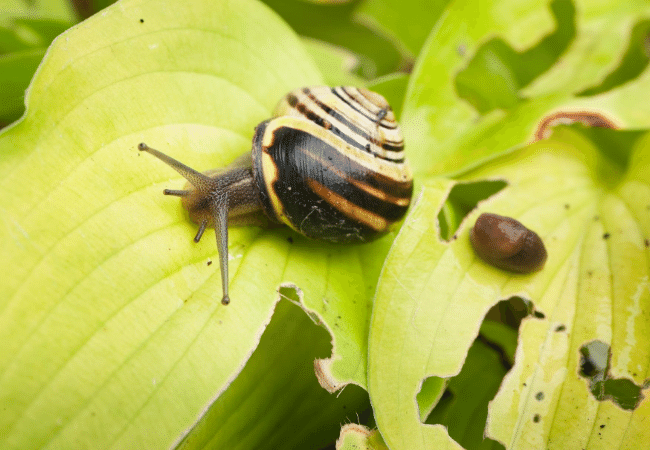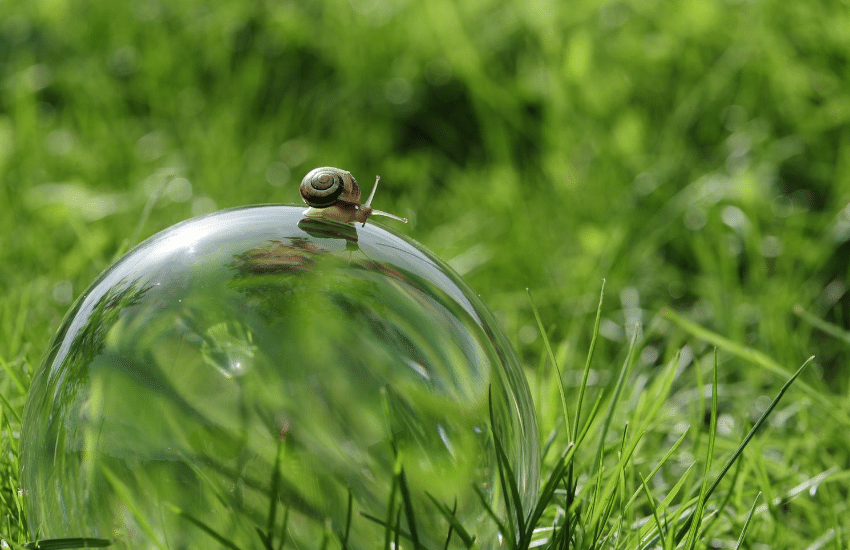There are around 60,000 species of snails and slugs in the world. The three types of snails are land, sea, and freshwater. The type of snail that you may see around your yard is a species of land snail. If it doesn’t have a shell, it is not a snail but a slug.
Snails are one of the many culprits that can do serious damage to a garden. They often do this damage under the cover of darkness, so it can be difficult to catch them in the act of their destruction. They feed on both living and decaying plants. While it is widely known that snails love many garden plants, what about grass? Do snails eat it?
Table of Contents
Snails and Grass
According to the University of California Integrated Pest Management Program, snails and slugs prefer turfgrass seedlings and herbaceous plants. Therefore, if you have freshly seeded or newly sprouted grass, snails can be a concern. Established lawns are not a preferred meal option for snails, which typically makes this mature grass less susceptible to damaged.
Detecting Snail Damage
Snails love moist and shady areas. They most often hideaway during the day unless it is cloudy. During droughts and cold weather, snails will rarely be seen because they seek cover to protect themselves from the elements. In other words, it is very difficult to detect that snails are causing damage.
However, there are some major clues that can link snails to the damage.
Firstly, snails will produce a mucus trail (snail slime) as they move forward. This silvery track is often visible, especially on surfaces like wood or landscape stones. If you spot the slime near the damage, you have a pretty good idea who did it.
Another sign is the damage itself. Snails will leave behind large ragged holes. This may be difficult to detect on the thin blades of new grass, but nearby plants or vegetables may reveal the damage. You can see an example of this damage in the below photo.

Snails can also be detected visually if you look hard enough. During the day, look near the damage for cool, dark, and moist areas where snails love to hide.
Common places to find snails are in the large leaves of hostas, under planters, beneath damp mulch, in ground cover, under woodpiles, under decks, and many other similar places. Eliminating these snail resting areas often can go a long way in eliminating snails over the long haul.
Eliminating Snails
One product that can be used to kill snails in the garden or lawn is Deadline Force II. You simply apply the liquid formula around the soil/grass surface where the snails are active. The surface should be damp before the formula is laid down. The snails will be attracted to formula, which is deadly to them.
A more natural and safer option for humans and pets is to use a product with the active ingredient iron phosphate. When snails or slugs consume the iron phosphate, they stop feeding and die within about 3 to 6 days. An example of one of these products is Garden Safe Slug & Snail Bait. This is a granular formula that can be used for both lawns and gardens. It can be applied manually or with a broadcast spreader around the area of infestation.
Other less effective methods include handpicking them as you see them or the use of traps. One popular DIY trap is the snail beer bait trap. Snails are attracted to beer (hey, so am I). A well thought out trap, such as the milk carton version in the video below, will provide decent results at helping eliminate snails and slugs.
Conclusion
Snails typically aren’t a major concern for lawns unless you have turfgrass seedlings. However, if they become a problem, they can be eliminated relatively easily by implementing one of the methods we discussed above. We particularly like Garden Safe, which is safe around pets/wildlife and actually works.
If you suspect snails or slugs are eating your lawn or garden, we hope this article was useful in helping you find a solution to your problem!
Sources:
https://www.snail-world.com/
https://en.wikipedia.org/wiki/Land_snail
http://ipm.ucanr.edu/PMG/PESTNOTES/pn7427.html

